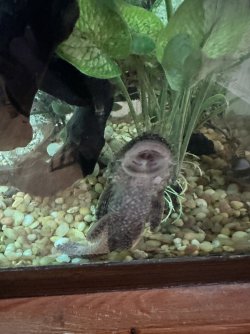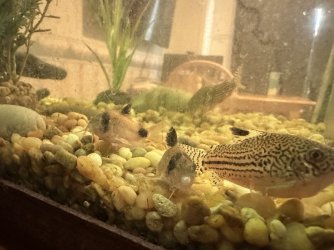The tank is 76 degrees, ammonia and nitrate 0
Are you mixing up nitrites and nitrAtes here?
What test kit are you using?
Can you please test again, and give us the numbers for ammonia, nitrites, and nitrAtes.
I'd be very surprised if nitrAtes were zero in an well established tank, unless it was very heavily planted and filtered and was lightly stocked with fish with a low bioload.
Your tank has fish like an 8 year old pleco, those have a high bioload, and I can only see fake plants, so even with large weekly changes, I'd expect to see some number high than zero for nitrAtes in a fully cycled, long established tank.
So need to know test kit, and numbers for ammonia, nitrites, and nitrAtes. Plus whether you have any live plants.
The tank is also shared with Spanish Ribbed Newts, but they have no problems with each other. My Bristlenose is 7 years old, the Sterbai is 8 years old and the Panda is 8 years old.
Can you give numbers for the full usual stocking, please?
How many newts?
How many of each species of cory?
It's great that the Bristlenose, A Sterbai and one of the Pandas have reached those ages! Suggests you're doing something right.

Have they always been in this same 30g?
How many years has the tank been set up for?
Were there any new additions in the tank stocking recently that could have introduced disease?
o regular 25% water changes as well as cleaning the gravel. I do right now have a bit more algae growing from Hikari mini algae wafers.
How often are the water changes Weekly? Monthly? We need specific info in order to be able to help, sorry for all the questions! But the answers will help me rule in or rule out potential issues or diseases. When you say algae growing on the Hikari wafers, do the fish leave the wafers and they go fuzzy?
Because uneaten food rotting in the substrate can both cause ammonia spikes, and also introduce nasty bacteria and fungus to establish themselves in the tank and substrate.
Cories nose around in the substrate for food, and while they can usually do that on gravel without too many problems, it's a different matter if the gravel is dirty and they are exposed to the bacteria and fungal spores growing and thriving in the gravel. I also see that at least two cories are mostly affected on their noses. Increasing my suspicion that this is a tank maintenance issue, and potentially easily rectified.
as well as cleaning the gravel. I do right now have a bit more algae growing from Hikari mini algae wafers. Could that have caused this? I’m trying to clean up the algae from the gravel. My fish were all fine before this algae issue.
Yes, I believe that could be part of what caused this.
The tank is also shared with Spanish Ribbed Newts
How many?
These were my fish early this morning and the fish eggs I just noticed.
Please please, be assured that this isn't a criticism of you!! I absolutely just want to help.
I suspect that this an long established tank for years, has worked fine for years, and over time, mulm, bacteria, detritus worms, and many other micro-beasties establish themselves in the tank. Most are harmless, many are helpful! But some can be harmful. And especially likely to establish themselves in a long established tank with a lot of mulm and detritus at the bottom of the tank, is heavily fed to make sure all these bottom feeders and the newts get enough food, but a lot gets uneaten and works it's way down through the gravel. Then is stirred up by these bottom feeders trying to reach the food and being more closely exposed to these potentially nasty bacteria, funguses and pathogens by the nature of being close to and feeding on and digging into the substrate.
Long established tanks with only 25% water changes that are maybe not done as often as they used to be, and with a high bioload and no live plants, and likely to gradually build up higher and higher levels of nitrAtes. This doesn't cause visible issues for a long time, since it's not so toxic to fish at lower levels. And since it's only building gradually, fish will do their best to cope with it for as long as they can, it just stresses them if it's too high, for too long, and eventually hits a tipping point.
But the high stress lowers immune systems, and leaves them more vulnerable to other stresses, and to secondary infections. Harder for them to fight off bad bacteria or heal a wound and fight off fungal infections, if they're also stressed by high nitrates, and digging into dirty substrate.
These photos tell me a few things, and raise another question:
Do you,
@Justcat12 or anyone else like
@Seisage @WhistlingBadger @Colin_T @DoubleDutch know what these are? They look like worms to me. maybe tubifex (do you feed the fish/newts tubifex worms?) or maybe a type a detritus worm. But says that the substrate needs more cleaning, and that there's an excess of rotting organic material that is causing an explosion in detritus worm populations, which is why they're reaching out of the substrate. Having detritus worms isn't harmful, they can even be beneficial, helping to break down that organic material and turn it into more harmless mulm. But they're usually hidden away in the substrate, so when they're climbing the glass or coming out of the substrate, it means there's been a population explosion in those worms, and the tank is being overfed, and/or under cleaned.
In this photo, the glass needs cleaning both inside and out. Remember that biofilm builds up inside the glass and makes it slimy. Generally harmless, and can provide food for some fish. But it's another thing that suggests not enough tank maintenance, and if there is a harmful pathogen, disease, bacteria, or fungus affecting the fish, then cleaning the glass and substrate, plus doing water changes with a gravel vac and thoroughly cleaning the tank and doing gradually increasing water changes, will reduce the amount of pathogens/bacteria/fungal spores/worm eggs etc in the tank. Then better chances the fish's immune system can fight off what pathogens etc remain.
Below the line I added to this photo where the gravel meets the glass shows that you're not gravel vacc-ing that deeply. The brown and black build up under the gravel is mulm, dirt, and organic matter and waste. Some of this is harmless, but this is a lot, and too much of it again, harbours all those potential nasties.
I think gradually working on deep cleaning the gravel, a bit at a time and systematically during bi-weekly water changes, removing and replacing more water each time, will show incredible results. And do more for the health of your tank and fish than any bottle of snake oil or medication can do.



